It has been a while since I posted anything for the 1908 project! This happens to be the month of the Femina issue I had scanned in, so luckily these three pages were just waiting for me to share!
I learn more from these period magazines than I otherwise could- since surviving examples of extant garments rarely show what was in fashion and can even more rarely be authenticated to a specific season and year.
Of particular interest to me, this article mentions women who SWORE they would not wear combinations and would only stick to petticoats. And here we see they are slowly converting, as the fashions dictated. I have read previously that some women began only wearing combinations in this period and no longer wore petticoats- and by combination, remember that there were combinations available during this time that were both corset-cover and petticoat in one. It wasn’t only the corset-cover and drawers combo we now think of when someone says, “Edwardian combinations”. So, they very well could refer to the petticoat version, or the bifurcated version.
I also find the mention of “Liberty” fabrics interesting. There was a large ad for Liberty of London fabrics in this issue, so we can assume Liberty had some sort of very novel fabric that everyone would know. Kind of like how Liberty fabric has taken the blogging/social media world by storm, and in that instance, we think of the lawn weight ditzy florals. Liberty actually has historically had MANY types of fabrics, and even solids. In this instance, “Liberty black” was likely a solid, but I’m unsure of fabric composition. If you know, please do let me know!
The author is SO DISGRUNTLED by those clinging, jersey dresses that took the fashion world by storm this year! Positively annoyed by the novel new things! It reads so differently than American middle-class magazines of this time, that fawned completely over anything “novel” and new.
And at the end of the article there’s a plug for the Femina magazine that included “die-cut” patterns. If only I could track *that* down. Die-cut, of course, referring to the tissue paper cut out patterns, not the overlapping printed lines that were the majority in French fashion publications of this period that included sewing patterns.
Did you learn anything new? Please let me know below! And if you choose to “pin”, share, or otherwise use, please credit back here. <3
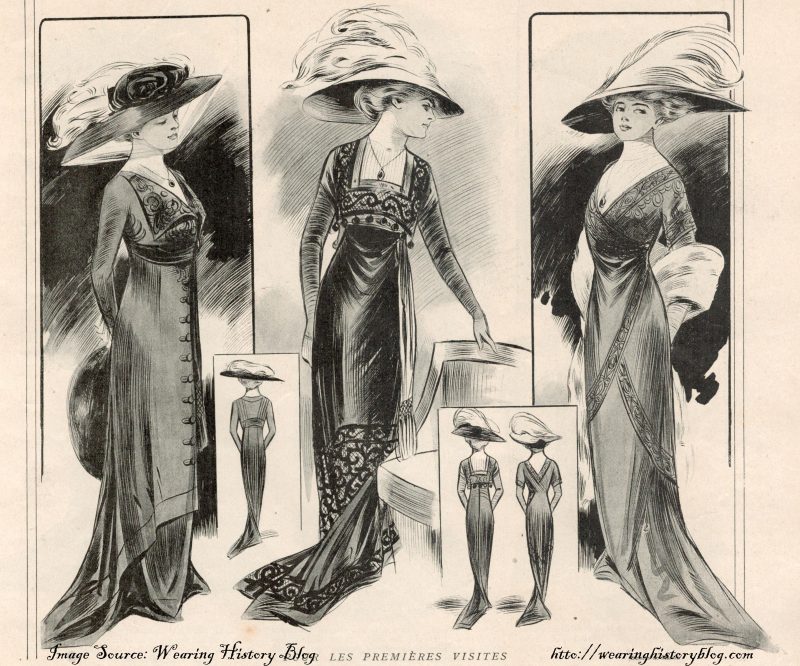
FOR FIRST VISITS
Purple cloth dress. Long front buttoning tunic. Soutache lapels with similar patterns arranged on the bodice. Velvet purple belt falling on the side and finished with a slender silk.
Golden Brown satin dress. The front of the skirt is completely cut out of transparent tulle. The bodice is adorned with a cut-out bertha and finished with balls of trimmings.
Myrtle Green cloth dress. Draped tunic and attached on the side. Trimmed with strips of soutache forming braid. Soutache patterns adorn the bodice. Guimpe and sleeves of white tulle.
To you! dear readers, who, in your letters, affirm to me your love of simplicity, how will you manage to reconcile your personal taste with current fashion requirements? Because we must recognize it well – even if we do not take this exaggeration literally, even if we do not accept the jersey and the tight dress, which made in this last season the fine days of our marvelous moderns — the fashion of today, that of tomorrow also attract attention with rather eccentric trends, the city toilettes that present themselves to our eyes, those announced to us for this fall and winter, are revealed quite difficult to bear, prone to many errors, prone to faults against good taste. Of a state of affairs against which neither you nor I can do anything, what should we conclude? It is that we must arm ourselves with reason, we resolve not to follow this fashion too closely, _who wants us lead too far. To correct it in what it may have that is excessive or shocking, to finally appropriate it, while observing its broad lines. to our needs, to our tastes, to our conveniences.
This process, which I recommend to female readers of Femina, for whom the good rule of conduct, in matters of toilets, is relatively easy to follow, when it comes to tailored suits. They will remain the guardians of this simplicity, abolished elsewhere, and they alone will retain a line reasonable, which will not exceed the limits to which we are accustomed.
If their skirts continue to flatten, at least they will have behind a big fold which will fill them out somewhat. Short for trotters, these skirts will lengthen on the contrary for dress suits, and in this case,
the tail does not double, as we started to do last year for prom dresses. We thus obtain a nice serpentine effect, which will make possible ~ only slightly flexible fabrics, such as drap satin, but which one must not think of with the big serges, the woven stripes of the past star; it is, however, serges that look the most chic when made of novelties. Navy blue or khaki persist, the latter trimmed with black liberty. However, we still see stripes of different tone, but which form a chevron; black always occupies one of the stripes, the other is often khaki, currant, old blue.
The jackets will be admirable, very elusive and generally quite long, all resembling each other by their flat sleeves, differing by their very short sizes in some, longer in others, which causes all combinations of vests and crossover shawls. We don’t know you to offer better models than those that our charming designer
Manon shows you on the pages of this issue. You will see that we garnish them with many soutaches, some entirely, others by detached motifs, that they are adorned with large buttons, that waistcoats, if they are not in liberty black, adopt all the velvet fantasies, from stripes to cashmere bottoms.
Nothing more classic, as you can see, nothing that doesn’t fit there, my dear readers, in your tastes and which does not meet your needs. And that confirms what I told you about the tailor, last citadel of simplicity and good manners. Sometimes, however, he emancipates himself, he also wants to stand out, and here is a little trotter, in one piece, – false air of a princess dress, very vague, closed in front by two rows of buttons, which leave between them a narrow apron. On the shoulders three Directoire pilgrims (?) and a large black liberty collar, attached at the side. And that really seems very chic. It is not very hot, despite the fleece, who, up to mid-leg line the thin satin sheet. Although it comes out of the usual note, this little trotter still remains close to simplicity, to which you aspire, my dear readers, and I am certainly not going to be able to say the same of our city toilettes.
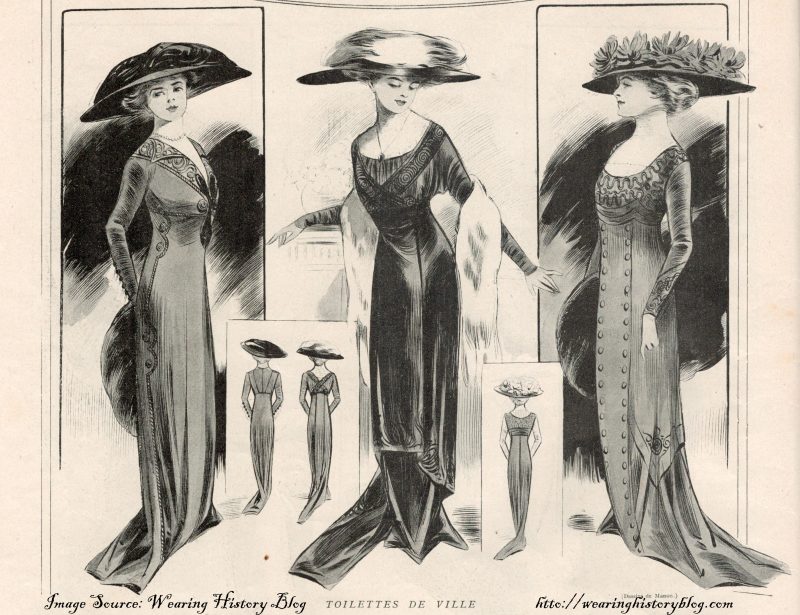
CITY TOILETS
Blue Marine cloth dress. Bolero movements and tunic underlined with a large black braid. Soutache bands forming waistcoat with turn-ups. Big trimming buttons. White tulle skirt. Black satin hat wrapped in a satin twist.Dress in black satin cloth. Crossover Tunic on the side and forming a narrow apron. Soutache braid framing the neckline. Soutache adorning the bottom of the tunic. Purple tulle skirt
Cloth dress <• taupe gray •>. Long narrow apron buttoned on both sides with satin buttons. Tunic with points on the sides with soutache design. Soutache corselete. White tulle skirt from which comes the white lace collar. Hat adorned with a crown of large tuberoses.
Ah! these city toilettes, in vain do we strive to simplify them, they nevertheless retain this stamp of eccentricity which is the mark of this fashion season. You won’t be able to leave them the line, which we were previously accustomed, under penalty of not looking fashionably dressed. So you have to bow down. In the absence of the << combination •>, which so many very correct women have nevertheless ended up adopting after having sworn that they would never come there, the petticoat-pants, in liberty black and whipped cream, offers a mixed solution to the most timorous, who do not want to give up the petticoat yet and yet fear its size old fashioned. But you will not free yourself, ladies, from the low cut, since the blouses themselves undergo it. It cuts a little low, you say? But we get used to it and the whole process certainly benefits. The belts remain round, deprived of these long floating panels, which were the thanks to this summer, the sleeves will be so long as to hide part of the hand and absolutely flat; even wide they will be, as well as the guimpe, different from the bodice. Pleated often, they will sometimes wrinkle across the arm, and then the gathers will end conspicuously on the outside of the arm by a tuck of about one centimeter. It’s a fashion for slim women. and which from the outset seems very penetrating.
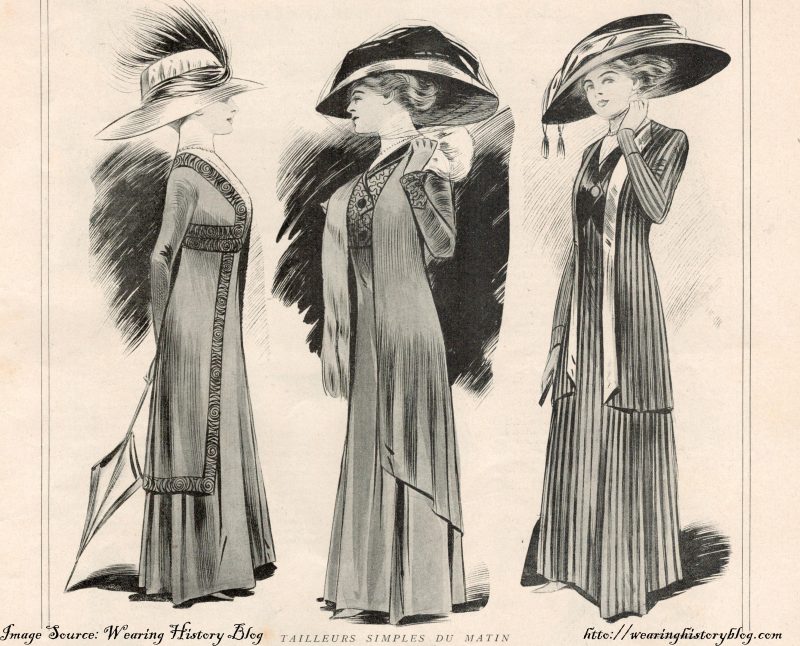
SIMPLE MORNING SUIT
Old red cloth trotter. Wide embroidered bands forming braid, neat with black embroideries. Skirt high waisted with white tulle collar and lace blouse. Large hat, right out of fantasy.Trotter with long jacket opening on a waistcoat of ottoman soutaché. Small royal velvet collar, piping of the same velvet emphasizing the buttons-
Dress in two-toned gray cloth. black satin waistcoat closed by a button. Long sheet lapels
of old gold. The waistcoat, very bright, opens on a collar of white tulle and the underside of the vest. Large hat embellished with ribbon.
What will be newer, more fancy too, will be the black colored pekiné fabric << stripes taken in biases~, forming only one side of the dress while the other side will be covered with a long tunic of liberty black. Very chic, no doubt, but very difficult to wear. The other fabrics which will know the vogue, are the meteor, the flexible satin, a lot of crepe de chine, less velvet.
I started with simplicity, and the more I advance in this column, the more I realize that I am moving away from it. So I come back to it with the dresses of the evening, I arrive at luxury. We are indeed promised real poems: aurora or pearly liberty, supple and shiny, silk muslin impalpable, covered with lace, embroidered with gold and silver. But … there is a but, the sticky form which has not taken hold of the tailors and who still makes some slight concessions – oh I very slight – when he it is about our city dresses, reigns here in absolute sovereignty. Or, they are made of two different fabrics, one side satin, the other tulle and lace, and these two fabrics not being attached together, let see a little feet. Here is one as an example: it is very flexible moonlight satin. The left side of the dress is satin, the right side is a tunic of white tulle, all embroidered which falls back to form a train absolutely detached from the rest of the dress. As I just did say the feet appear.
If this shocks you and you demand a little scale, this scale will be wrapped, in a way, around the body and caught up in the bottom of the skirt with a trimming pattern or a large flower that will tighten the fabric around the legs.
A really charming detail that we notice on many new dresses, it is a drapery which escapes from the bodice to come and wrap around the left arm. We also see pretty effects – Venice, Cluny, Ireland, which will especially appeal to older women. For young girls it is useless to say, I think, that such eccentricity is not allowed. their dresses remain nice, round, simple.
Let me finally, my dear readers, in ending this column, draw your attention to the other pages where Femina reviews the coats, tea-gowns, hats, and also the toilet of toddlers. I have no doubt that when you have leafed through them, you will be very suitably informed about the various aspects of fashion, in this coming season.
MARTE-ANNE L’HEUREUX.
P. S, – In response to several readers, I remind you that there is a special edition Femina key which gives a year 48,011 real ladies and 24 die-cut patterns as well as special advice for the execution of these models. The subscription at this edition is 18 francs for France and Belgium; 30 francs for abroad. (Sending of a free specimen against o fr. 25.)
M-A . L’. H.
For those who wish it, the original French text is included below.
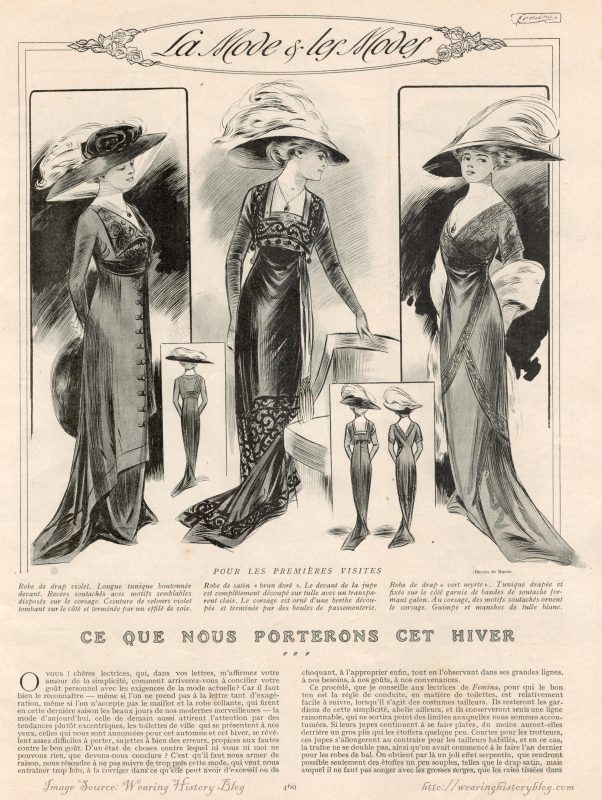
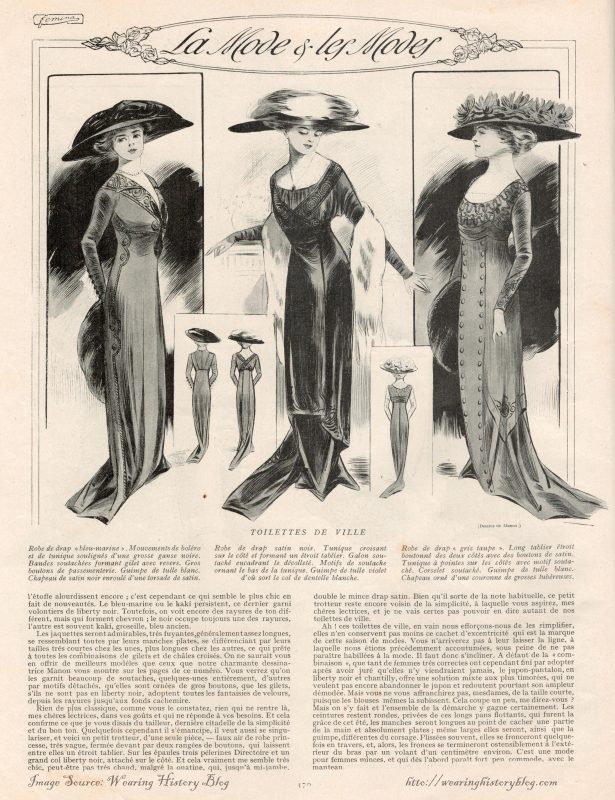
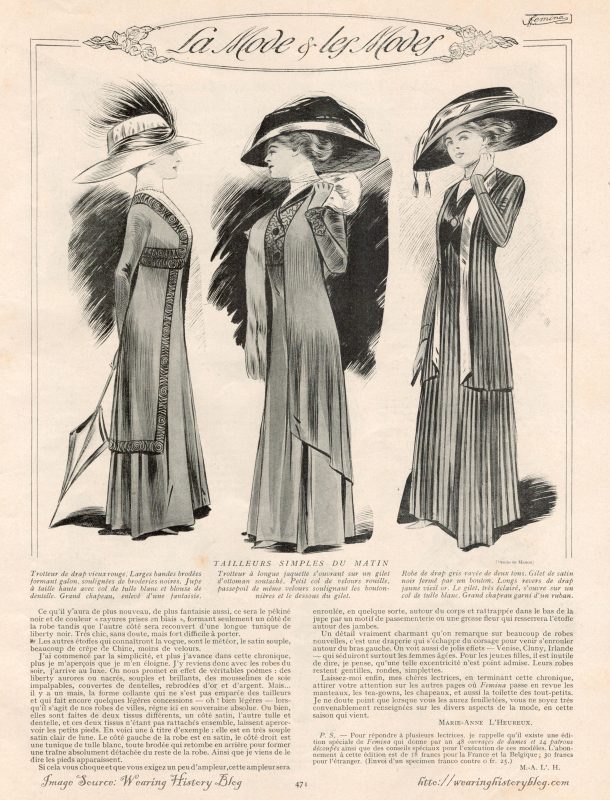

Statuesque Seamstress
October 11, 2022 at 10:54 am (3 years ago)I find it fascinating that many of the writer’s comments about maintaining simplicity of line and not slavishly following trends could have been lifted almost verbatim from the advice of modern French style instructions.